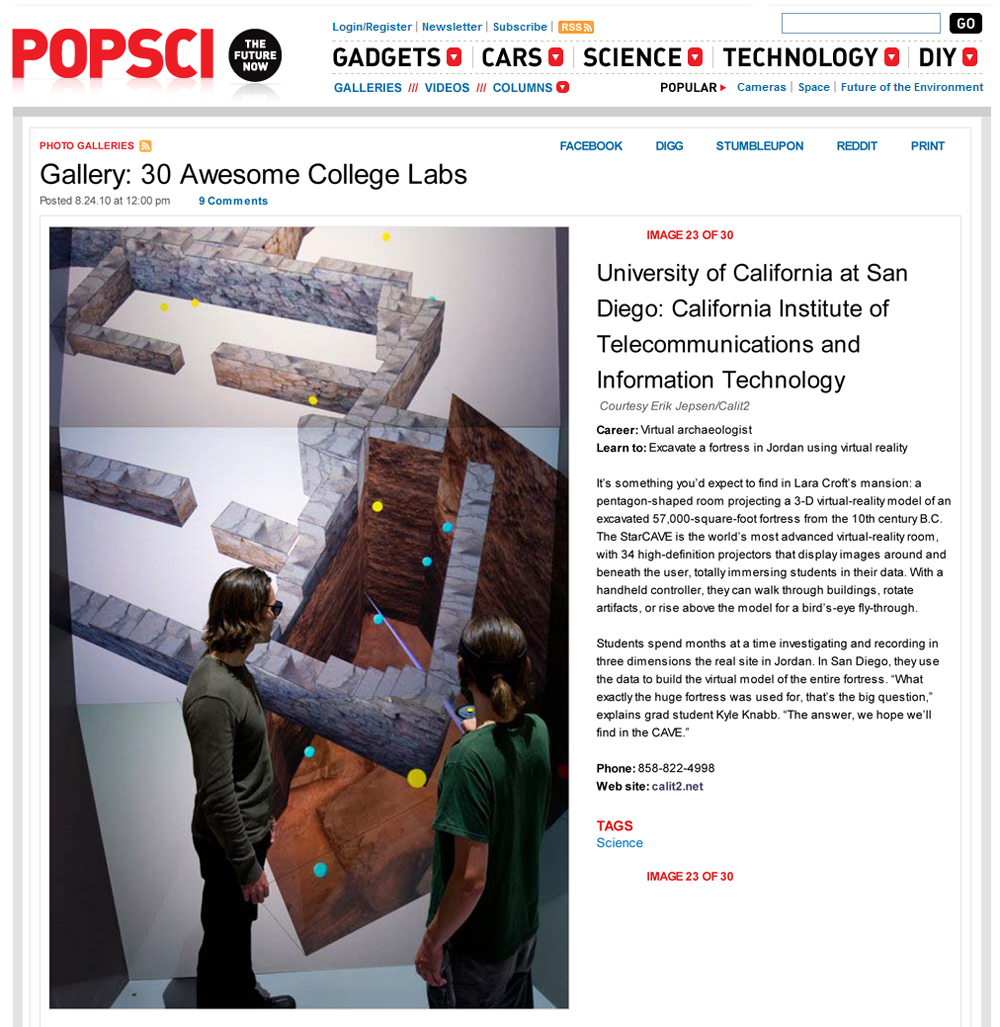Popular Science Highlights Calit2's 'Awesome' Lab for Archaeology
San Diego, Sept. 2, 2010 -- With students returning to school for the 2010-'11 academic year, Popular Science magazine is once again pointing to Calit2's StarCAVE virtual-reality, 3D environment at UC San Diego as an awesome attraction for students interested in a variety of disciplines, including archaeology.
|
Last September, the magazine profiled the archaeological expedition course taught by UC San Diego professor Thomas E. Levy, who is also an associate director of Calit2's Center of Interdisciplinary Science for Art, Architecture and Archaeology (CISA3). Popular Science included the course in a feature on "Seven of the Country's Coolest SciTech Courses."
In the newest version of the back-to-school list, the magazine's editors re-conceived the feature as a photo gallery of "30 Awesome College Labs".
The StarCAVE is featured along with labs where students get to crash vehicles, blow up explosives, build rockets, test space gear in zero gravity, design videogames, construct robots, measure lava flow on active volcanoes, study social entrepreneurship in developing countries, and even create software to search for signs of intelligent life in the universe.
At Calit2, the StarCAVE -- a five-sided room that is part of a new generation of Cave Automated Virtual Environments (CAVEs) originally developed by the University of Illinois at Chicago's Electronic Visualization Lab -- is used by disciplines ranging from molecular biology to structural engineering.
“Someday, not too far off, everyone could own interconnected workspaces and playspaces entirely made of 3D screens with directional audio that know where we are looking and provide immersive, accurate perspective real-time graphics, just like the StarCAVE and its 3D TV sibling, the NexCAVE," said Tom DeFanti, co-creator of the CAVEs at EVL and now Director of Visualization at Calit2. "That’s what my life’s work has been about.”
Popular Science focuses on the StarCAVE's value to archaeologists, who are part of an NSF-funded IGERT program announced last month to train engineers and scientists in methods for cultural heritage diagnostics. After building a computer model based on 3D recording of data from extensive field excavatiosn of a 10th Century B.C. site in Jordan, UCSD faculty and students use the virtual-reality environment to repeatedly re-visit the site to better understand what all of the data from the excavated fortress really mean. "The StarCAVE is the world's most advanced virtual-reality room, with 34 high-definition projectors that display images around and beneath the user, totally immersing students in their data," reports the magazine's online edition. "With a handheld controller, [students] can walk through buildings, rotate artifacts, or rise above the model for a bird's-eye fly-through."
"Calit2 and its amazing array of open-minded engineers and computer scientists have opened up a kind of 'DreamWorks Studios' for archaeologists at UCSD," said Levy, who also holds the Norma Kershaw Endowed Chair in the Archaeology of Ancient Israel and the Neighboring Lands. "Because humans think in 3D, many of the 3D technologies being developed at Calit2 can be harnessed to enable us to visualize our data in ways that the 2D page is incapable of representing. The digital or 'cyber-archaeology' research we are doing at Calit2 is taking full advantage of these rapidly developing tools. Thanks to collaborative research between faculty and graduate students -- most of whom grew up with mobile phones, laptops and other digital devices -- we are at one of the most exciting methodological phases in the history of archaeology as a discipline."
The article quotes archaeology graduate student Kyle Knabb on what the virtual-reality environment could mean for the research team: "What exactly the huge fortress was used for, that's the big question. The answer, we hope we'll find in the CAVE."
UC San Diego is not the only University of California campus highlighted as being among the 30 "awesome" college laboratories on Popular Science's 2010 list. The lab of evolutionary biologist Michael Dawson at UC Merced allows marine biology students to dive with jellyfish in a lake on Palau island in the South Pacific, to determine whether there is a link between ocean energy and the movement of jellyfish and other ocean-dwelling species. And UC Berkeley is where students can become "alien hunters" -- developing new search algorithms for analyzing data from radio telescopes looking for signals from intelligent life in the universe.
Related Links
CISA3
CISA3 Archaeology
Popular Science Gallery
Media Contacts
Doug Ramsey, 858-822-5825, dramsey@ucsd.edu

